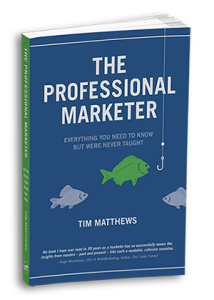Estimated Reading Time: 3 minutes
 Authenticity. Everyone wants it. Nobody wants anything inauthentic. Fake. Substitute. Artificial. Ersatz. Even though it’s intuitive, too many marketers ignore this basic desire and put out advertisements and campaigns that come across as phony.
Authenticity. Everyone wants it. Nobody wants anything inauthentic. Fake. Substitute. Artificial. Ersatz. Even though it’s intuitive, too many marketers ignore this basic desire and put out advertisements and campaigns that come across as phony.
Marketing needs to be authentic. Marketers need to understand that their customers want something real and deliver it to them in every way – in the product, in the promotion, and in their language. No customer wants to be sold. Or on the receiving end of hype. Why is it that a marketer can plainly tell a friend at a backyard barbecue what their company does, but on Monday, when they get into the office, out come the superlatives, buzzwords and corporatespeak?
Truth is, consumers are savvier than ever. Think back to commercials you’ve heard from the early days of radio and television. They sound smarmy, right? We are exposed to so much more media today that when we hear something inauthentic that sounds like marketing – as opposed to just talking to us as a customer – our shields go up.
Contributing to this wariness, in my opinion, is that social media exposes us to direct and candid language every day. In the bright light of all that social conversation, typical marketing copy is exposed for what it really is.
I can’t tell you how to be authentic. You have to adopt it as a mindset. But here are four ideas to get you started down the path.
Source your products and ideas from your customers. This is an age-old practice in marketing that’s often ignored. Let me give you a recent example of how to do this. I’m a big soccer fan, and of Major League Soccer (MLS). I’ve enjoyed watching the startup league develop over the years. About fifteen years into its existence, MLS management realized that going after soccer moms and Hispanic Americans was the wrong marketing strategy. MLS had right in front of them hard-core soccer fans who wanted to connect with its teams in a deep and real way. Yet the league wasn’t marketing itself that way.
Around that time, a new club called New York City FC came into the league. The New York club wanted to connect with the fans and establish a true New York identity. What did they do? They sourced their logo from the fans, and then they let the fans vote on their favorite. In soccer, the crest, as it’s called, has a special meaning to soccer fans. Sourcing the crest directly from the fans was a brilliant idea. The club didn’t end up using any of the submissions verbatim, but their designers used many of the ideas from the fan submissions. That wasn’t even the important part. The fact was that they asked – that they cared – created a deep connection and respect from the fans. A very different approach than my local soccer team, the San Jose Earthquakes, whose logo, to me, makes no sense, has no connection with an earthquake, and was done without any input from fans like me.
Secondly, speak directly and plainly. Can we finally retire the adjective modifier ‘cutting-edge’? Does anyone really want a cutting-edge or state-of-the-art product? Why do we speak like this? Drop the hype, the superlative, the empty promises. Customers don’t need that. They just want to understand what something is and how it works, and maybe how it’s better. No need to lay it on thick. Just tell them straight and customers will appreciate it. It’s more like a direct, authentic conversation.
Next, use your customers’ words. Why struggle to write about your product in a way that tries to convince somebody else to buy it when you’ve got customers who are already convinced? We all know the power of referral sales, the net promoter score, and word of mouth marketing. Spend more of your marketing time connecting with customers, asking them for their advice, and for their comments. Ask them how they would describe your product, and then use their words not yours in your marketing copy. Their words will connect with your future customers much more directly, and be much more authentic than you can ever imagine. A very easy exercise you can do tomorrow is to conduct a short survey of your customer base. Ask them these two questions:
- Why did you buy our product?
- What would you say to someone thinking about buying our product?
Chances are high you will get some interesting phrases and buyer motivations you can use in your marketing copy.
Last, be honest. By this I mean be transparent. When you make a mistake, own up to it, don’t spin it. When you can’t do something, explain why. When you have done something that has hurt your customers, apologize and let them know how you’re going to make sure it doesn’t happen again. Nobody’s perfect. Customers understand this. Quite often they will thank you for the clear and prompt communication. That’s the way to build loyalty, by having honest, which is a close cousin of authentic, conversations.
These are but four ways you can be more authentic in your marketing. I hesitated when I drafted this article as it seems sort of inauthentic to present a recipe on how to be authentic. Authenticity is a mindset, not a prescription. There are many ways to do it. Do what works for you. Most importantly, be yourself.
 Want to learn even more about marketing?
Want to learn even more about marketing?